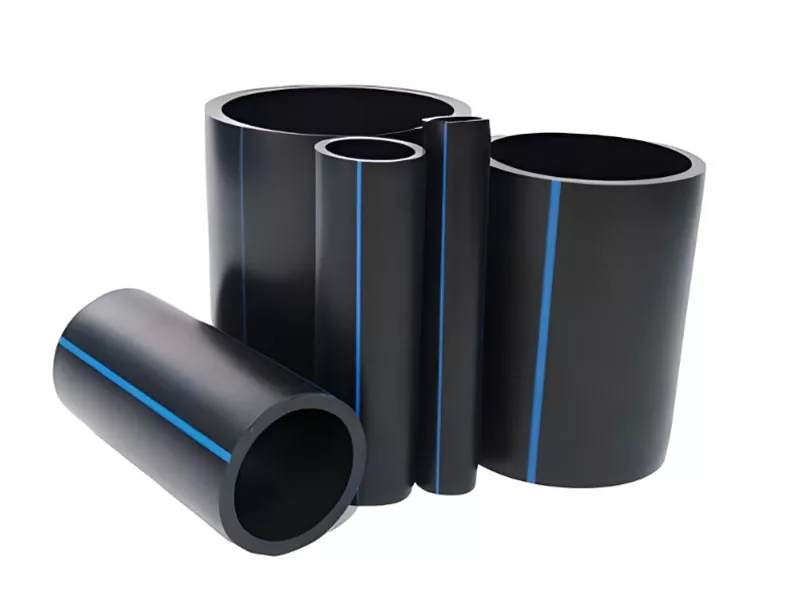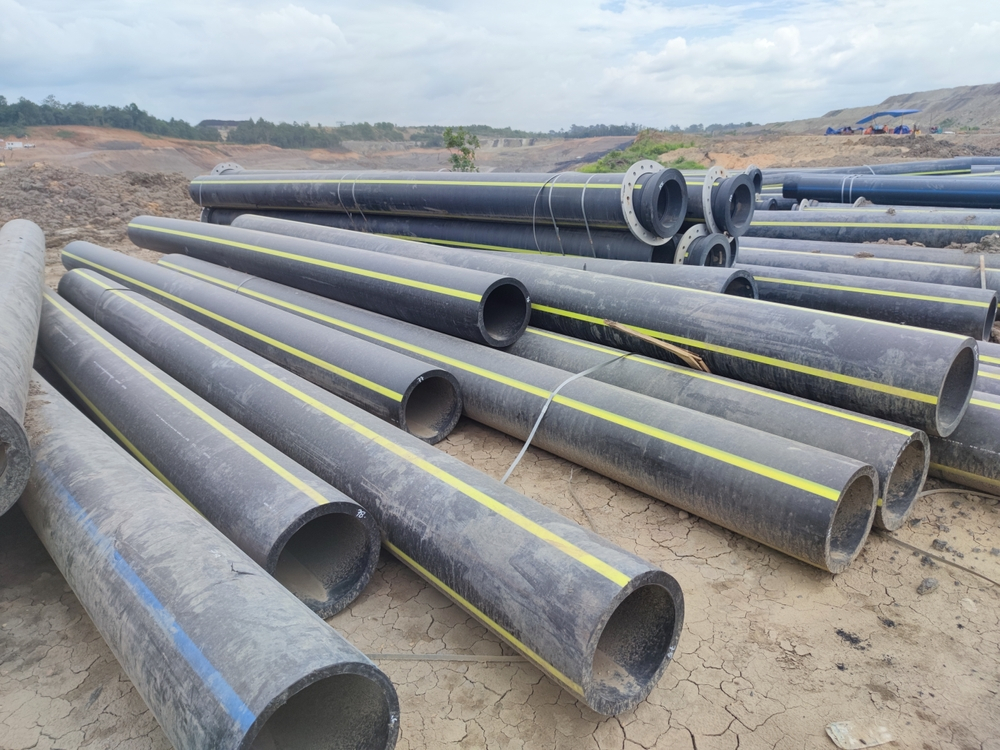Discover the Production Process Behind High-Quality HDPE Pipeline and Its Applications
The production process of premium HDPE pipelines is detailed and methodical. It starts with the selection of raw materials that improve efficiency. Following this, ethylene undergoes polymerization to form resin, which is after that shaped through extrusion. Quality assurance is paramount, guaranteeing that the end product meets strict criteria. The journey of HDPE pipelines doesn't finish with production. Their applications throughout various sectors reveal a wider value worth checking out.
Recognizing HDPE: Qualities and Advantages

High-density polyethylene (HDPE) is a flexible thermoplastic understood for its sturdiness and resistance to various environmental elements. This product exhibits excellent tensile strength, making it suitable for demanding applications. Its low-density framework adds to a lightweight product, helping with convenience of taking care of and installment. HDPE also showcases amazing resistance to chemicals, which lessens deterioration when subjected to severe compounds.
The product's low dampness absorption further boosts its durability, making it ideal for usage in pipelines and tank. Furthermore, HDPE is resistant to ultraviolet (UV) radiation, ensuring that items keep their honesty also when exposed to sunlight. Additionally, its adaptability permits the creation of complex forms without endangering toughness. The environment-friendly nature of HDPE, often acquired from recycled products, contributes to its charm, promoting sustainable techniques in production. In general, these properties and advantages make HDPE a recommended option for numerous industrial and consumer applications.
Basic Material Selection for HDPE Manufacturing
The selection of basic materials for HDPE manufacturing is vital to verify the end product meets the preferred specifications and high quality standards. High-density polyethylene (HDPE) is mainly created from polymerized ethylene, originated from fossil gas such as natural gas or crude oil. The high quality of these feedstocks substantially influences the mechanical and thermal homes of the final HDPE.
Ingredients additionally play a significant duty in boosting HDPE's efficiency, consisting of anti-oxidants, UV stabilizers, and colorants, which enhance resilience and resistance to ecological elements. The option procedure should take into consideration not just the chemical composition of the raw materials however likewise their processing attributes to guarantee reliable manufacturing.
Additionally, the sourcing of raw materials must focus on sustainability and conformity with ecological policies, as responsible practices are vital in today's market. Eventually, mindful basic material option lays the foundation for producing top notch HDPE pipelines appropriate for diverse applications.
The Extrusion Refine: Shaping HDPE Pipeline
The extrusion process plays an essential function fit HDPE pipes, starting with careful material preparation techniques that ensure ideal flow and consistency. Similarly crucial is the style of the die, which straight affects the last dimensions and surface high quality of the pipe. Together, these variables add substantially to the performance and high quality of HDPE pipe manufacturing.
Material Preparation Methods
Reliable manufacturing of HDPE pipelines starts with precise product prep work techniques, specifically the extrusion procedure. During this phase, high-density polyethylene resin is very first dried out to remove wetness, ensuring optimal flow qualities. The material is then fed right into the extruder, where it undertakes heating and melting, transforming into a thick state. This heating procedure is meticulously managed to preserve the material's integrity and efficiency. The molten HDPE is forced through a die, shaping it right into a continuous pipeline kind. Proper temperature level management during extrusion is essential, as it straight impacts the material's residential or commercial properties and the final item quality. Once shaped, the HDPE pipe is cooled down and cut to defined sizes, all set for succeeding handling and applications.
Die Layout Significance
Precision in die style plays an essential role in the extrusion procedure of HDPE pipes. The die serves as the final shaping tool, straight affecting the pipe's dimensions, wall surface thickness, and surface area finish. A well-designed die warranties uniform product flow, lowering defects such as irregularities and vulnerable points. The geometry of the die must be maximized to fit the details buildings of HDPE, including its viscosity and thermal behavior throughout extrusion. In addition, the cooling rate of the product as it travels through the die can significantly affect the pipe's structural honesty. Consequently, buying sophisticated die modern technology is vital for manufacturers aiming to produce top quality HDPE pipes that fulfill industry criteria and customer assumptions.
High Quality Control Procedures in HDPE Manufacturing
Various variables influence the top quality of HDPE pipeline production, effective quality control measures are essential to assure consistency and reliability in the final product (Pipe Supplier American Plastics Midland). Trick quality assurance practices consist of rigorous material examination, verifying that the raw polyethylene fulfills well established standards for purity and thickness. During the extrusion procedure, parameters such as temperature, stress, and cooling time are closely checked to maintain dimensional precision and architectural honesty
In enhancement, post-production screening is essential; producers typically perform hydrostatic tests to examine the pipe's toughness and resistance to pressure. Aesthetic assessments for surface area problems even more improve top quality guarantee. Accreditation from pertinent requirements companies, like ASTM or ISO, offers an additional layer of trustworthiness. By applying these complete quality assurance actions, producers can decrease issues, improve performance, and make certain that the HDPE pipelines meet the particular requirements of different applications, inevitably bring about customer complete satisfaction and trust fund in the product.
Applications of HDPE Pipe Across Industries
HDPE pipelines are utilized throughout different industries as a result of their durability and convenience. In water distribution systems, they assure effective shipment, while in wastewater management, they offer dependable solutions for waste transportation. Furthermore, farming watering networks take advantage of HDPE's resistance to rust and adaptability, making it an excellent selection for modern farming techniques.

Water Distribution Equipments
A significant variety of sectors depend on high-density polyethylene (HDPE) pipes for efficient water circulation systems. Understood for their resilience and resistance to corrosion, HDPE pipes are extensively used in community water supply networks, agricultural irrigation, and commercial applications. Their lightweight nature facilitates simple handling and setup, decreasing labor prices and time. Additionally, HDPE pipes can suit various pressure degrees, making them appropriate for both low and high-pressure systems. Pipe Supplier American Plastics Midland. The flexibility of the product allows for smooth integration right into existing infrastructure, lessening the need for extensive excavation. In addition, HDPE's resistance to chemical seeping guarantees that the water delivered stays safe and tidy, making it an ideal choice for keeping the top quality of drinkable water across different industries
Wastewater Administration Solutions
Reliable water distribution systems also pave the means for ingenious wastewater administration remedies, where high-density polyethylene (HDPE) pipelines play a significant role. Renowned get more info for their resilience and resistance to corrosion, HDPE pipes are ideal for delivering wastewater in different setups. Their flexibility enables simple installation in complicated environments, reducing the need for substantial excavation. In addition, HDPE's smooth interior surface area lowers friction, improving flow rates and performance. These pipes are additionally immune to chemical leaching, making certain that impurities do not jeopardize the surrounding atmosphere. Industries, towns, and treatment centers progressively depend on HDPE pipes for their integrity and longevity, making them a favored selection for modern-day wastewater management systems. This versatility highlights the essential relevance of HDPE pipelines across countless applications.
Agricultural Irrigation Networks
Agricultural watering networks profit substantially from using high-density polyethylene (HDPE) pipes, which give reliable and reliable water distribution to plants. HDPE pipelines are light-weight, making them very easy to deliver and install, while their versatility allows for numerous setups in diverse terrains. These pipes demonstrate excellent resistance to deterioration, chemicals, and UV radiation, guaranteeing durability in rough agricultural settings. Furthermore, their smooth indoor surface area lessens friction loss, optimizing water flow and reducing energy expenses associated with pumping. The durability of HDPE pipelines, commonly surpassing half a century, contributes to decrease maintenance and replacement expenditures. Subsequently, farmers significantly count on HDPE pipelines to boost irrigation effectiveness and promote sustainable farming practices, eventually leading to boosted crop yields and resource conservation.
Future Trends in HDPE Pipeline Technology
As the demand for sustainable and reliable infrastructure expands, improvements in HDPE pipeline innovation are positioned to change numerous industries. Emerging trends consist of the integration of wise innovations, such as sensors and IoT abilities, which help with real-time monitoring of pipe problems, reducing upkeep prices and avoiding leakages. Furthermore, the development of innovative manufacturing methods, such as 3D printing, is making it possible for the production of facility, tailored pipeline styles that satisfy particular job needs.
The focus on recycling and circular economic situation techniques is driving the advancement of HDPE pipes made from recycled materials, enhancing sustainability. Boosted jointing techniques, such as electro-fusion and mechanical fittings, are additionally boosting installment efficiency and reliability. The growing emphasis on ecological laws is pressing suppliers to embrace greener production procedures, making sure that HDPE pipes not only meet market requirements however likewise promote a more lasting future for facilities growth.
Frequently Asked Inquiries
How Does HDPE Contrast to Various Other Plastic Products?
HDPE exceeds numerous various other plastic materials regarding sturdiness, chemical resistance, and adaptability. Its low thickness and high tensile toughness make it excellent for different applications, commonly exceeding options in both performance and longevity.
What Are the Environmental Effects of HDPE Manufacturing?
The ecological impacts of HDPE manufacturing consist of greenhouse gas exhausts, power consumption, and prospective contamination from producing processes. Furthermore, incorrect disposal can bring about dirt and water contamination, elevating issues concerning long-term ecological effects.
Can HDPE Water Lines Be Recycled?
Yes, HDPE pipes can be reused. Several centers approve utilized HDPE for handling, transforming it into new products. This reusing contributes to sustainability efforts, minimizing plastic waste while saving resources and power in the production cycle.
What Is the Life Expectancy of HDPE Piping?

Just How Do Temperature Level Variants Impact HDPE Pipe Efficiency?
Temperature level variants substantially affect HDPE pipe performance, influencing versatility and strength. Heats can bring about softening, while reduced temperature levels might trigger brittleness, eventually affecting the pipeline's toughness and suitability for numerous applications in varied atmospheres.